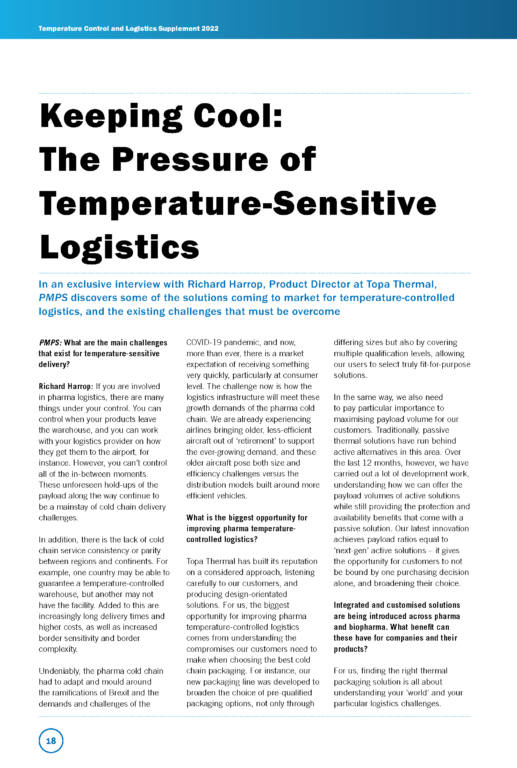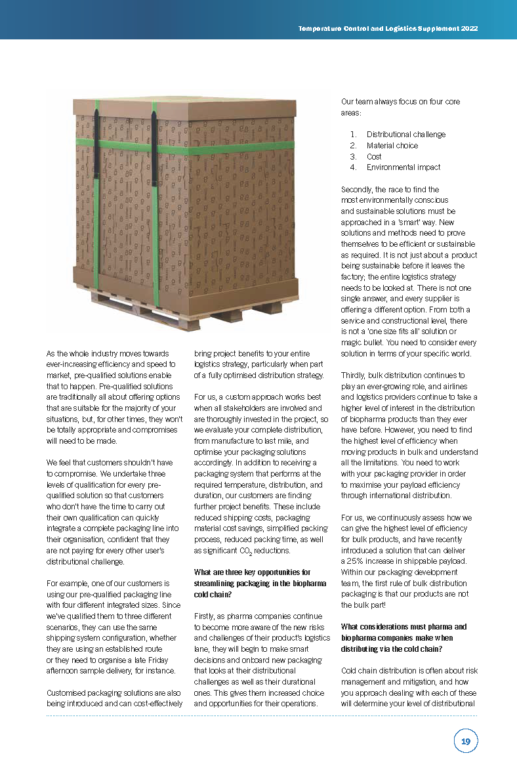Keeping Cool: The Pressure of Temperature-Sensitive Logistics
Richard Harrop, Product Director at Topa Thermal, discusses the solutions coming to market for temperature-controlled logistics, and the existing challenges that must be overcome



First published in PMPS Pharmaceutical Manufacturing and Packing Sourcer: Temperature Control & Logistics Supplement 2022 © Samedan Ltd
What are the main challenges that exist for temperature sensitive logistics and delivery of pharmaceuticals?
If you are involved in pharma logistics there are many things under your control. You can control when your products leave the warehouse, you can work with your logistics provider on how they get them to the airport, for instance. However, you can’t control all of the in-between moments. These unforeseen hold ups of your payload along the way continue to be a mainstay of cold chain delivery challenges.
In addition, there is the lack of cold chain service consistency or parity between regions and continents. For example, one country can guarantee a temperature-controlled warehouse, but another may not have the facility. Added to this are increasingly longer delivery times and higher costs as well as increased border sensitivity and border complexity.
Undeniably, the pharma cold chain had to adapt and flex with the ramifications of Brexit and the demands and challenges of the Covid19 pandemic and now more than ever there is a market expectation of receiving something very quickly, particularly at consumer level. So, the challenge now is how the logistics infrastructure will meet these growth demands of the pharma cold chain. We are already experiencing airlines bringing older less-efficient aircraft out of “retirement” to support the ever growing demand and these older aircraft pose both size and efficiency challenges versus the distribution models built around more efficient vehicles.
What is the biggest opportunity for improving pharma temperature-controlled logistics?
Topa Thermal have built their reputation on a considered approach, listening carefully to our customers and producing design-orientated solutions. For us, the biggest opportunity for improving pharma temperature-controlled logistics comes from understanding the compromises our customers need to make when choosing the best cold chain packaging. For instance, our new °Connex GEO line was developed to broaden the choice of pre-qualified packaging options, not only through differing sizes but also by running multiple qualification levels allowing our users to select truly fit-for-purpose solutions.
In the same way, we also need to pay particular importance to maximising payload volume for our customers. Traditionally passive thermal solutions have run behind active alternatives in this area. Over the last 12 months, however, we have carried out a lot of development work, understanding how we can offer the payload volumes of active solutions while still providing the protection and availability benefits that come with a passive solution. Our latest °Connex OVERWRAP is the first solution in our industry that achieves payload ratios equal to ‘next gen’ active solutions. So, it gives the opportunity for customers to not be bound by one purchasing decision alone. We have broadened the choice.
Integrated and Customised solutions are being introduced across pharma and biopharma. What benefit can these have for companies and their products?
For us, finding the right thermal packaging solution is all about understanding your ‘world’ and your particular logistics challenges.
As the whole industry moves towards ever increasing efficiency and speed to market, pre-qualified solutions enable that to happen. Pre-qualified solutions are traditionally all about offering options that are suitable for the majority of your situations. But for other times, they won’t be totally appropriate and there will be compromises to be made.
We feel that customers shouldn’t have to compromise. So we have undertaken 3 levels of qualification for every pre-qualified solution. So that customers who don’t have the time to carry out their own qualification, can quickly integrate a complete packaging line into their organisation, confident that they are not paying for every other user’s distributional challenge.
For example, one of our customers is using our pre-qualified °Connex GEO line with 4 different integrated sizes. Since we’ve qualified them to 3 different scenarios they can use the same shipping system configuration, whether they are using an established route or if they need to organise a late Friday afternoon sample delivery, for instance.
Customised packaging solutions are also being introduced and can cost-effectively bring project benefits to your entire logistics strategy, particularly when part of a fully optimised distribution strategy.
For us, a custom approach works best when all stakeholders are involved and are thoroughly invested in the project so we evaluate together your complete distribution, from manufacture to last mile, and optimise your packaging solutions accordingly. In addition to receiving a packaging system that performs at the required temperature, distribution and duration our customers are finding additional total project benefits. These include reduced shipping costs, packaging material cost savings, simplified packing process, reduced packing time as well as significant CO2 reductions.
What are three key opportunities for streamlining packaging in the biopharma cold chain?
“It is not just about a product being sustainable before it leaves the factory that makes it, but you need to look at the whole of your logistics strategy.”
Firstly, as pharmaceutical companies continue to become more aware of the new risks and challenges of their product’s logistics lane, they will begin to make smart decisions and onboard new packaging that looks at their distributional challenges as well as their durational ones. This gives them increased choice and opportunities to their operations.
At Topa Thermal, we always focus on four core areas, distributional challenge, material choice, cost and environmental impact.
Secondly, the race to find the most environmentally conscience and sustainable solutions must be approached in a ‘smart’ way. New solutions and methods need to prove themselves as efficient or as sustainable as they should be. It is not just about a product being sustainable before it leaves the factory that makes it, but you need to look at the whole of your logistics strategy. There is not one true answer, and every supplier is offering a different option. From both a service and constructional level, there is not a ‘one size fits all’ solution or magic bullet. You need to consider every solution in terms of your world.
Thirdly, bulk distribution continues to play an ever-growing role and Airlines and logistics providers continue to take a higher level of interest in the distribution of biopharma products than they ever have before. However, you need to find the highest level of efficiency when moving products in bulk and understand all the limitations. You need to work with your packaging provider as to how to maximise your payload efficiency through international distribution.
For us, we continuously look hard at how we can give the highest level of efficiency for bulk products and have recently introduced a solution that can deliver a 25% increase in shippable payload (°Connex OVERWRAP). Within our packaging development team the first rule of bulk distribution packaging is that our products are not the bulk part!
What considerations must pharma and biopharma companies make when distributing via the cold chain?
Cold chain distribution is often about risk management and mitigation And how you approach dealing with each of these will determine your level of distributional success, as well as how much you end up spending. Trying to figure this out alone will rarely result in uncovering the full picture, but working hand in hand with providers, to create a joined up holistic approach continues to prove itself as the optimal route.
Currently there are also huge pressures on the logistics environment and the physical act of distribution is becoming increasingly expensive. It is therefore more important than ever before to maximise your distribution and squeeze the last drop of efficiency out everything!
What innovations are helping to improve the capability to tackle these considerations?
Optimised pallet solutions such as the °Connex OVERWRAP is one innovation that is helping to tackle these pressures. Designed with input from airline and logistical industries these and other integrated systems are helping to optimise distribution efficiency.
Equally, with the growth of track and trace technology, certainly in the field of reusable solutions, comes clarity of asset management and live product temperature and environment updates, for example give us as packaging providers the opportunity to develop solutions that are even more suited to your world.
Temperature-controlled logistics is subject to environmental challenges. What can the industry do to improve this outlook in the next 5-10 years?
The industry can address the environmental and sustainability challenges it faces on several fronts. Firstly, we need to continue working on projects at a material science level, to bring in the next generation bio plastic products and move away from petroleum-based products.
Secondly, there are already many new solutions being developed and launched across 2022-23 that will use up to 50% fewer plastic products. New plastic tax rules in the UK for instance, put many companies in position where they now must look at how much plastic they bring into their organisation. And we can only expect similar schemes around the world. Things such as this will serve as a ‘stick’ to drive further environmental efficiencies.
However, the reality is that petroleum-based insulation like EPS and PU are still some of the most effective insulators in the industry in terms of price and performance and although some eco materials are nearing their performance levels we are not quite there yet. Added to this it is often the case that the truly eco-beneficial materials come at an increased price due to their manufacturing scale versus that of the more established petrochemical-products. To mitigate this, we are again making sure that the alternate materials we onboard at Topa not only offer a like for like performance level but also offer new benefits that could not be achieved with traditional plastics and serve to further challenge some of our customers’ thermal distribution compromises.
Finally, by increasing freight optimisation and creating more thermally efficient solutions, that fit the actual challenge, you can make significant environmental savings. If everyone is doing that, it could quite simply mean one less truck on the road, one less plane in the sky.

As Product Director, Richard Harrop leads the product development and marketing teams at Topa Thermal, working to ensure the most effective thermal packaging solutions are brought to market. With a career in the thermal packaging industry panning 20 years, his energy and enthusiasm for all things temperature control is infectious. So much so you can almost see PCM running through his veins!
“It shouldn’t be the burden of the customer to make compromised choices or settle for an ‘almost right’ thermal packaging solution.”
